Lifestyle
Master the Art of Safe Tanning
Navigate the essentials of safe tanning to achieve a radiant glow, but wait—what crucial tips are you missing for flawless skin?

To master the art of safe tanning, start by understanding your skin type. This will guide your exposure time: fair skin should limit sessions to 5-20 minutes, while darker skin can last up to 30 minutes. Stick to two tanning sessions per week to allow your skin to recover. Always use a high-quality moisturizer and apply tanning lotion with SPF30 for protection. Stay hydrated and exfoliate before tanning for an even glow. Monitor your tanning sessions closely to avoid overexposure. There's more to explore about maintaining and enhancing your tan effectively, so keep going to discover those tips!
Key Takeaways
- Determine your skin type using the Fitzpatrick Scale to tailor your tanning duration and exposure limits effectively.
- Hydrate and moisturize your skin daily to maintain suppleness and prolong your tan while preventing peeling.
- Limit tanning sessions to twice a week and a maximum of 60 sessions annually to allow your skin to recover.
- Use SPF30 tanning lotion for protection against harmful UV rays while achieving a bronzed look.
Understanding Skin Types
Understanding your skin type is essential for safe tanning, as it directly influences how your skin reacts to UV exposure.
The Fitzpatrick Scale categorizes skin into different types, each with varying tolerances. If you have fair skin, start with just 5-7 minutes of sun exposure, capping sessions at 20 minutes. For medium skin, begin with 7-10 minutes, with a maximum of 25 minutes. If your skin is dark, you can start at 10-13 minutes, going up to 30 minutes.
Knowing your skin type helps you determine effective tanning strategies while preventing damage.
Always remember, UVA rays penetrate deep and cause premature aging, while UVB rays can lead to painful sunburn.
Prioritize your skin's health!
Risks of Over-Tanning
Over-tanning poses important health risks, including an increased likelihood of skin cancer and accelerated aging. When you expose your skin excessively to UV rays, you double your chances of developing melanoma, which can be life-threatening.
Additionally, over-tanning leads to premature wrinkles, age spots, and sagging skin, making you look older than you are. You might even find yourself addicted to tanning, facing withdrawal symptoms and emotional distress when trying to quit.
Remember, sunburn isn't just painful; it greatly raises your skin cancer risk. Prioritizing health over that bronzed look is essential.
Keeping your tanning sessions moderate not only helps you achieve a beautiful glow but also protects your skin from long-term damage and regret.
Safe Tanning Guidelines

To guarantee safe tanning, it's crucial to follow specific guidelines that protect your skin while helping you achieve a beautiful glow.
Limit your tanning sessions to twice a week, allowing at least 24 hours between them for ideal skin recovery. Stick to a maximum of 60 sessions annually to minimize damage.
Understand your skin type and adjust your exposure time accordingly—fair skin should start with 5-7 minutes, while darker skin can begin with 10-13 minutes. Tanning three times a week is generally sufficient for a noticeable glow.
Remember, different tanning beds emit varying levels of UV rays, so choose wisely based on your skin's needs.
Prioritize your skin health to avoid long-term consequences.
Preparation for Tanning
Preparing your skin before tanning can greatly enhance the quality and longevity of your tan.
Start by staying hydrated; drinking plenty of water keeps your skin supple and prevents peeling.
Use a high-quality moisturizer daily to lock in moisture, especially before tanning.
Consider applying a tanning lotion with SPF30 to protect your skin from harmful UV rays while still achieving that bronzed look.
Exfoliate your skin 24 hours prior to tanning for an even application and to remove dead skin cells.
Avoid makeup on tanning days to guarantee maximum effectiveness.
Maintaining Your Tan

Maintaining your tan requires regular care and attention to keep your skin looking vibrant and healthy.
Start by staying hydrated; drinking plenty of water helps prevent peeling and keeps your skin elastic.
Use high-quality moisturizers daily, which lock in moisture and prolong your tan.
After tanning, apply a tan extender to enhance and maintain your color.
Exfoliate your skin gently 24 hours before each tanning session to achieve an even application.
Limit your sessions to no more than two a week, allowing your skin to recover.
Always remember to apply a moisturizer with SPF30 before sun exposure to protect your skin.
Regular skin checks are essential to monitor any changes and guarantee your skin remains healthy while you enjoy your tan.
Tanning Products Recommendations
Choosing the right tanning products can greatly enhance your results and protect your skin during the tanning process. Look for lotions specifically designed for tanning, containing moisturizing ingredients like aloe vera or coconut oil to keep your skin hydrated.
A product with SPF30 is essential to shield against harmful UV rays. Before tanning, apply a high-quality moisturizer to lock in moisture, and consider using a tan extender post-session to maintain your color.
Exfoliating 24 hours prior helps guarantee an even application, so don't skip this step. Avoid makeup before tanning to maximize effectiveness.
Monitoring Tanning Sessions
Keeping track of your tanning sessions is essential to guarantee you're not overexposing your skin to harmful UV rays.
Monitor the duration and frequency of your sessions based on your skin type. For fair skin, limit sessions to 5-20 minutes; medium skin should aim for 7-25 minutes, while dark skin can handle 10-30 minutes.
Stick to two sessions per week to allow your skin to recover and avoid exceeding 60 sessions annually. Always allow at least 24 hours between tanning sessions for ideal skin health.
Remember, moderation is key. Regularly check your skin for any changes, and prioritize your health over achieving a darker tan.
Frequently Asked Questions
How Does Diet Affect the Quality of My Tan?
Diet plays a crucial role in your tan's quality. Eating foods rich in antioxidants, like fruits and vegetables, can enhance your skin's health, while staying hydrated helps maintain an even, glowing complexion.
Can I Tan Indoors if It's Cloudy Outside?
Yes, you can tan indoors even if it's cloudy outside. Indoor tanning beds provide consistent UV exposure, allowing you to achieve a tan regardless of the weather. Just remember to follow safe tanning practices for healthy results.
What Are Natural Alternatives to Tanning Beds?
"There's more than one way to skin a cat." You can use natural alternatives like self-tanners, bronzers, or even coffee scrubs. These options provide a sun-kissed glow without the risks associated with tanning beds.
How Can I Reduce Tan Lines?
To reduce tan lines, you can wear less clothing or use self-tanners to blend areas. Regularly exfoliate and moisturize to promote even skin tone, and consider using bronzers for a more uniform look.
Is It Safe to Tan While on Medication?
It's essential to check with your doctor before tanning while on medication. Some meds can increase sensitivity to UV rays, heightening burn risk. Always prioritize your health and follow professional advice for safe tanning practices.
Conclusion
To sum up, mastering safe tanning is all about balance.
For instance, consider Lisa, who loved the sun but neglected protection. After a few intense sessions, she faced painful sunburn and long-term skin damage.
By understanding her skin type and following safe tanning guidelines, she transformed her routine and achieved a healthy glow without the risks.
Remember, it's possible to enjoy the sun while keeping your skin safe—just prioritize your health and follow these essential tips!
Lifestyle
The Impact of Hydroponic Farming on Herb Flavor Profiles
Unlock the secrets of hydroponic farming and discover how it transforms herb flavor profiles in ways you never imagined. What awaits you next?

Hydroponic farming greatly boosts herb flavor profiles, giving you access to herbs that are more vibrant and aromatic. By using precise nutrient solutions, you can control factors like electrical conductivity to intensify the flavors and essential oil concentrations. The controlled environment also reduces plant stress, ensuring uniform growth and consistent taste. Hydroponically grown herbs often outshine their soil-grown counterparts, delivering richer flavors and a fresher taste year-round. If you're curious about how to refine these flavors even further, there's plenty more to discover about hydroponic techniques that enhance your herb experience.
Key Takeaways
- Hydroponic farming enhances herb flavor profiles through controlled nutrient delivery, maximizing essential oil production and flavor intensity.
- Adjusting electrical conductivity (EC) levels in nutrient solutions can concentrate flavor compounds in herbs like basil and mint.
- Environmental factors such as light spectrum and mild stress improve essential oil production and aromatic qualities in hydroponically grown herbs.
- Hydroponic herbs often have more consistent flavor profiles and higher essential oil concentrations compared to soil-grown counterparts.
- Consumer perceptions favor hydroponic herbs for their freshness and flavor, with many willing to pay a premium for them.
Hydroponics Overview
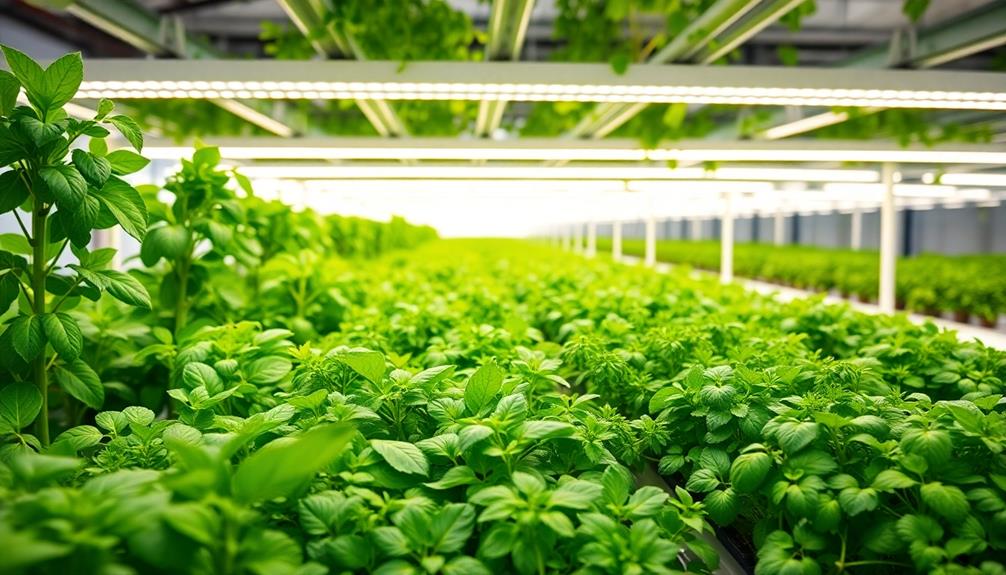
Hydroponics is revolutionizing the way we grow plants, offering a soil-less method that directly delivers nutrients to the roots through a nutrient-rich water solution. This innovative approach, often implemented through hydroponic systems, allows you to enhance the growth conditions for your plants.
By controlling environmental factors such as light and temperature, you can create a perfect setting for controlled environment agriculture, which is essential for maximizing the production of vital oils and enhancing flavor profiles in fresh herbs. For example, certain techniques can be employed to replicate the growing conditions of herbs used in dishes like Nettle and Potato Soup, resulting in vibrant flavors and aromas.
When using hydroponics, you gain the ability to fine-tune the nutrient solution, ensuring that your plants receive exactly what they need for peak growth. This precise control not only promotes faster growth but also greatly influences the taste and aroma of herbs compared to traditional soil-grown varieties.
As a result, you'll discover that herbs like basil, mint, and cilantro thrive in this system, yielding a more consistent and concentrated flavor profile.
Moreover, hydroponics enables year-round herb production, so you'll always have access to fresh and flavorful herbs, regardless of seasonal changes. This means you can elevate your culinary creations with vibrant flavors all year long.
Nutrient Control in Hydroponics

Controlling nutrient delivery in hydroponics can greatly enhance the flavor profiles of your herbs. With hydroponic systems, you have the ability to manage nutrient control precisely, optimizing the balance of essential minerals and compounds necessary for flavor development.
For example, the rich blend of spices used in Mushroom Masala can be replicated by adjusting nutrient levels to enhance earthy flavors in herbs. By adjusting the electrical conductivity (EC) levels in your nutrient solutions, you can concentrate flavor compounds considerably; higher EC levels often lead to more intense flavors.
You can also manipulate specific nutrients to boost flavors in particular herbs. For instance, increasing nitrogen and sulfur concentrations can enhance the robust tastes of onions and garlic. This level of customization allows you to tailor your nutrient solutions to meet the unique needs of each herb, ensuring that the flavors meet market preferences.
Moreover, the controlled environment of hydroponics supports consistent nutrient absorption, resulting in uniform flavor quality across your herb crops. This consistency reduces the variability often seen in soil-grown herbs, making your produce not only flavorful but also reliable.
Environmental Factors Affecting Flavor

Flavor in hydroponically grown herbs isn't just about nutrient control; environmental factors play a considerable role too. In a controlled environment, you can precisely manage light, temperature, and humidity, all of which are critical for producing essential oils that enhance flavor profiles.
For instance, adjusting the nutrient solution's electrical conductivity (EC) can concentrate flavor compounds in herbs like basil and mint. Additionally, certain herbs used in Brazilian cuisine, such as cilantro, thrive under specific conditions that can amplify their unique flavors, contributing to dishes like salpico.
Manipulating nutrient delivery and stress levels can also intensify flavors. Applying mild stress, such as limiting water supply, encourages plants to increase their flavor compound concentration.
Additionally, variations in the light spectrum from LED grow lights can considerably impact the production of volatile aromatic compounds in herbs like rosemary and thyme.
Thanks to hydroponic systems, you can achieve consistent growth conditions year-round. This stability minimizes seasonal variation, ensuring that your herbs maintain a reliable flavor profile despite external environmental changes.
Flavor Profile Variations in Herbs

Herbs can surprise you with their diverse flavor profiles, often varying greatly even within the same species. When you grow herbs hydroponically, you can achieve enhanced flavor through careful nutrient management and controlled environments.
By adjusting the nutrient solution's electrical conductivity (EC), you can intensify flavor, particularly in herbs like basil and mint, where higher EC levels correlate with a more robust taste.
In these controlled environments, manipulating light spectrums promotes the production of volatile aromatic compounds essential for flavor development. You might also find that applying slight to moderate stress—such as limiting water or nutrients—can concentrate flavor compounds in herbs like rosemary and thyme, leading to a more intense flavor experience.
Additionally, the genetic selection of specific herb cultivars bred for flavor can greatly impact taste and aroma. Choosing the right cultivars is essential for ensuring that your hydroponically grown herbs deliver the fresh produce you desire.
Comparison With Soil-Grown Herbs
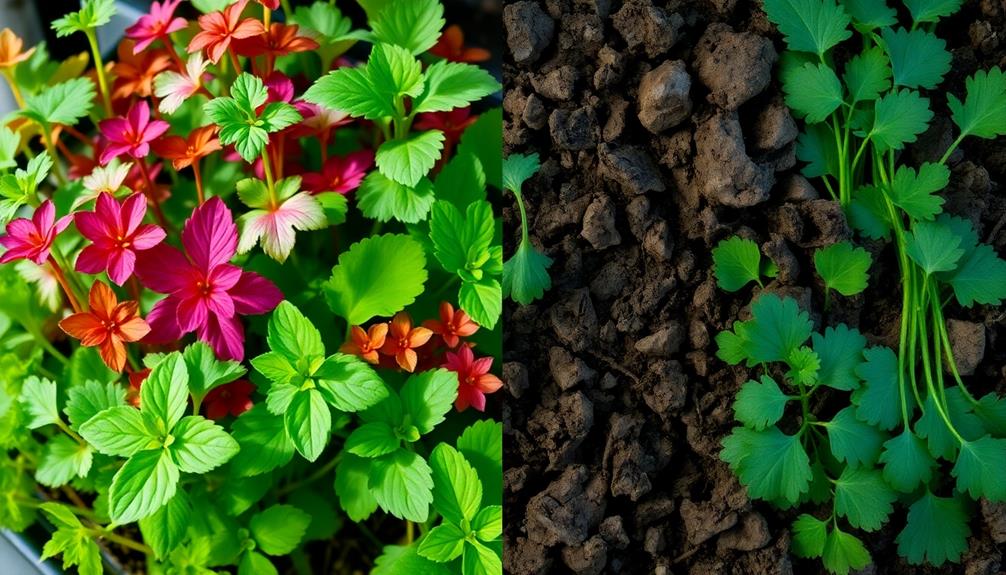
When you compare hydroponic herbs to those grown in soil, you'll notice significant differences in nutrient accessibility.
Hydroponics offers a controlled environment that allows for precise nutrient delivery, leading to more consistent flavors.
In contrast, soil-grown herbs can vary widely in taste and quality, influenced by factors like soil health and environmental conditions.
Nutrient Accessibility Differences
In hydroponic farming, growers benefit from the ability to provide plants with direct access to a precisely controlled nutrient solution. This method notably improves nutrient accessibility, allowing for ideal nutrient absorption, which is vital for producing robust hydroponic herbs.
Unlike soil-grown counterparts, where nutrient availability can fluctuate, hydroponics guarantees consistent nutrient delivery. This consistency minimizes plant stress and promotes uniform growth, ultimately leading to enhanced flavor profiles.
Research indicates that hydroponically grown herbs often contain higher concentrations of essential oils, directly contributing to their flavor intensity. By tailoring nutritional solutions, you can boost specific flavor compounds, resulting in herbs that taste more pronounced than those cultivated in soil.
Hydroponic techniques, like adjusting electrical conductivity (EC) levels, further amplify these flavor compounds, making your herbs more flavorful.
Flavor Consistency Variability
Achieving flavor consistency in hydroponically grown herbs offers a distinct advantage over their soil-grown counterparts. The controlled environment of hydroponics allows you to manage nutrient delivery, light exposure, and other environmental conditions effectively. This minimizes the variability that often affects soil-grown herbs, which can fluctuate due to soil quality and weather changes.
Consider these key factors contributing to flavor consistency in hydroponic herbs:
- Controlled Nutrient Delivery: Precise management of nutrients leads to consistent flavor profiles.
- Higher Essential Oils: Hydroponic herbs often contain more essential oils, enhancing taste and aroma.
- Reduced Disease Risk: Without soil, you eliminate soil-borne diseases, which can compromise flavor.
- Uniform Shelf Life: Hydroponic herbs tend to have longer shelf lives, maintaining flavor integrity over time.
Techniques to Enhance Herb Flavor
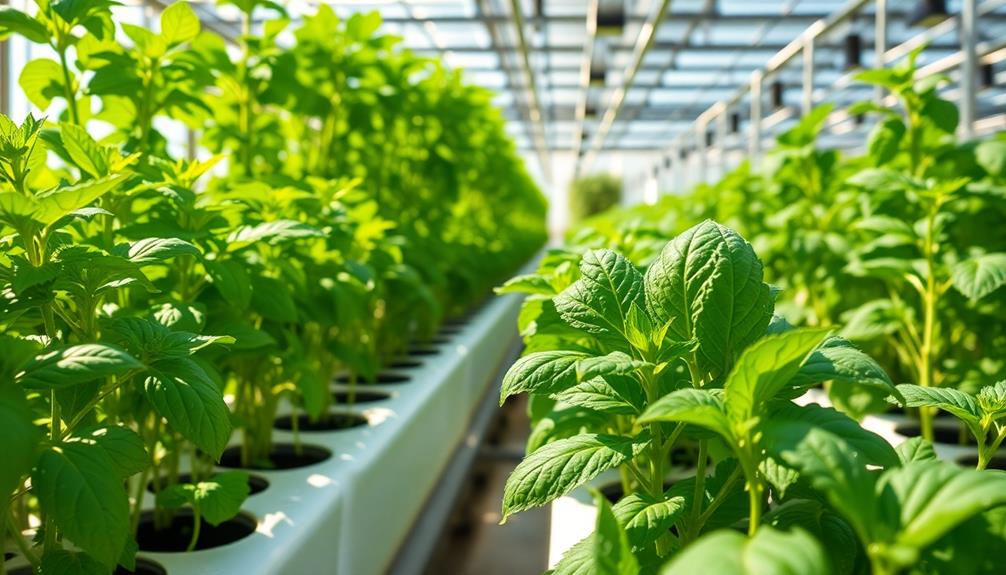
To enhance the flavor of your hydroponic herbs, you can implement strategic nutrient timing, apply mild stress methods, and control the environmental conditions.
By carefully adjusting these factors, you can boost essential oil production and concentrate flavor compounds in your crops.
Let's explore how each technique can elevate your herb's taste profile.
Nutrient Timing Strategies
Timing your nutrient applications can be the secret ingredient to releasing exceptional flavor profiles in hydroponically grown herbs.
By strategically adjusting nutrient timing, you can greatly enhance the flavor of your herbs. Different growth stages respond best to specific nutrient levels, allowing you to tailor the feeding regimen for maximum impact.
Consider these key strategies:
- Boost nitrogen levels early on to promote lush leaf growth, setting a strong foundation for flavor.
- Adjust sulfur levels during the later stages to intensify flavors in herbs like garlic and onions.
- Monitor electrical conductivity (EC); increasing EC levels in advanced hydroponic systems can yield more aromatic herbs.
- Reduce water availability just before harvest to concentrate essential oils and flavor compounds in herbs like basil and mint.
Stress Application Methods
Applying stress to hydroponically grown herbs can greatly enhance their flavor profiles, making techniques like water reduction and nutrient limitation powerful tools in your cultivation arsenal. By applying slight to moderate stress during the growth cycle, you can concentrate aromatic compounds in herbs such as basil and mint.
Here are some effective stress application methods to evaluate:
| Technique | Effect on Flavor Profiles |
|---|---|
| Water Reduction | Increases essential oil concentration |
| Nutrient Limitation | Enhances intensity in aromatic herbs |
| Nitrogen/Sulfur Boost | Boosts flavor in garlic and onions |
| Targeted Timing | Optimizes flavor without harming plants |
| Controlled Light/Temp | Further enhances flavor characteristics |
Environmental Control Techniques
Environmental control techniques play an essential role in enhancing the flavor profiles of hydroponically grown herbs. By managing the growing conditions, you guarantee that your herbs need the right environment for peak flavor development.
Here are some key strategies:
- Light Spectrum Control: Adjusting light levels to specific spectrums can boost essential oil production, elevating the aromatic qualities of basil and mint.
- Nutrient Solutions Management: Regularly monitor and precisely adjust your nutrient solutions, focusing on macronutrients and trace elements, to maximize flavor in cilantro and parsley.
- Temperature & Humidity Regulation: Maintaining ideal temperatures between 60-70°F (15-21°C) and humidity levels of 40-70% supports vigorous growth and enhances flavor development.
- Stress Techniques: Implement slight to moderate stress, like reducing water availability or adjusting nutrient concentrations, to concentrate flavor compounds in herbs like rosemary and thyme.
Consumer Perceptions of Hydroponic Herbs

When it comes to hydroponic herbs, many consumers view them as not just fresher but also more flavorful than their soil-grown counterparts. This perception largely stems from the controlled growing conditions that enhance the production of essential oil and flavor compounds.
Studies reveal that hydroponically grown herbs often exhibit higher concentrations of these compounds, resulting in a more intense taste experience that appeals to gourmet cooks and food enthusiasts alike.
Market research shows that about 70% of consumers are willing to pay a premium for hydroponic herbs, recognizing their superior quality and freshness over traditional options.
You'll also find that hydroponic herbs typically boast a longer shelf life and maintain their flavor profile better during transportation, further boosting consumer perceptions of their overall quality.
Feedback from culinary professionals consistently highlights that hydroponic herbs outshine their traditional counterparts regarding flavor.
This has led many high-end dining establishments to prefer hydroponic varieties, reinforcing the notion that these herbs aren't just a trend but a demonstration of innovation in agriculture.
Embracing hydroponic herbs can elevate your culinary experiences.
Sustainability and Flavor Quality
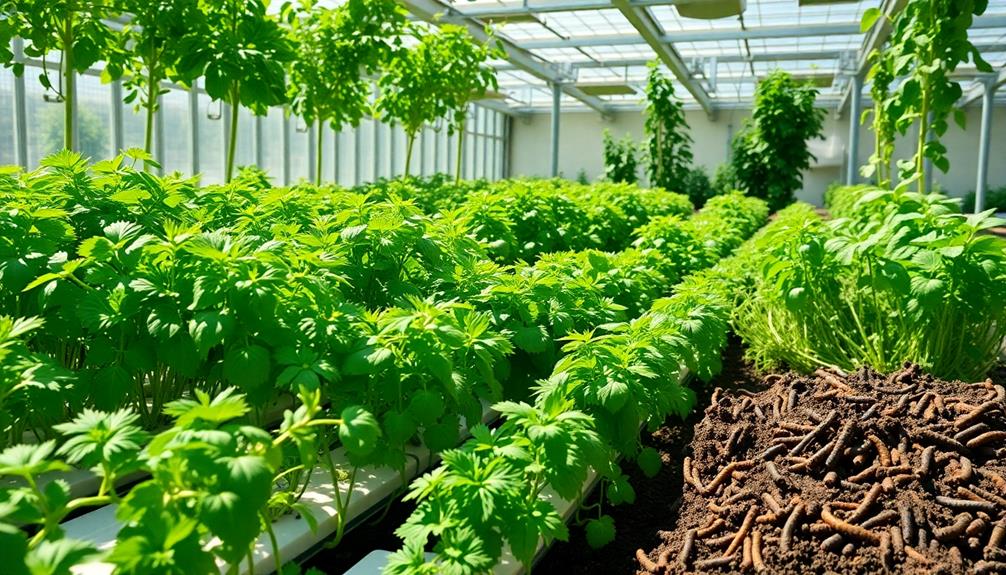
When you engage with hydroponic farming, you're not just enjoying fresh herbs; you're also benefiting from a resource-efficient system that minimizes waste.
By controlling nutrient delivery, you can enhance the flavor of your herbs while ensuring sustainability.
This approach not only conserves water but also optimizes conditions for growing intensely flavorful produce year-round.
Resource Efficiency in Hydroponics
Harnessing innovative techniques, hydroponic farming stands out for its remarkable resource efficiency, particularly in water usage. By utilizing 70-80% less water than traditional farming, you can enjoy herbs that not only taste better but also have a lower environmental impact.
The closed-loop systems minimize water loss and promote nutrient reuse, enhancing the flavor profiles of the herbs you grow.
Here are some key points to take into account about resource efficiency in hydroponics:
- Better Control: You can manage light, temperature, and nutrient delivery precisely, resulting in consistent flavor profiles year-round.
- Water Quality: Closed systems help maintain high water quality, essential for the health of hydroponic plants.
- Nutrient Optimization: Adjusting nutrient solutions, like electrical conductivity levels, can intensify flavor without sacrificing sustainability.
- Health Benefits: Cleaner herbs are produced with fewer pesticides, preserving their natural flavors and health benefits.
Nutrient Control and Flavor
Hydroponic farming's resource efficiency not only conserves water but also sets the stage for enhanced flavor through meticulous nutrient control.
In hydroponic systems, you can precisely manage nutrient delivery, adjusting levels to meet the specific needs of your herbs. This control allows you to boost flavor profiles considerably. For instance, increasing electrical conductivity (EC) in nutrient solutions can elevate the taste of crops; levels reaching 8.0 have been shown to enhance flavor compared to lower levels of 3.0.
When you focus on nutrient solutions rich in nitrogen and sulfur, you can intensify the flavors in herbs like garlic and onions. Managing root zone conditions and applying slight stress during critical growth stages can further concentrate flavor compounds, resulting in more robust taste profiles.
Additionally, hydroponically grown herbs often exhibit higher concentrations of essential oils and aromatic compounds, heightening their overall flavor intensity compared to those grown traditionally.
Impact on Culinary Experiences

The impact of hydroponic farming on culinary experiences is significant, especially when it comes to flavor. By utilizing a controlled environment, hydroponic produce often boasts higher concentrations of essential oils and flavor compounds.
This precise nutrient management not only enhances the flavor but also allows chefs like you to create customized flavor profiles that elevate your dishes.
Here are some key benefits of hydroponic herbs:
- Year-round availability guarantees you always have fresh herbs on hand, regardless of the season.
- Hydroponically grown herbs typically maintain their flavor and aroma longer than traditional soil-grown varieties.
- Studies show that herbs like basil and cilantro often exhibit superior flavor intensity, making them a preferred choice for many consumers.
- The ability to adjust nutrient solutions allows for specific flavor enhancements, leading to unique taste experiences.
With hydroponic farming, you can explore an array of fresh herbs that transform your culinary creations.
Embrace this innovative growing method, and enjoy the depth and complexity that hydroponic herbs bring to your kitchen.
Future Trends in Hydroponic Flavor Development
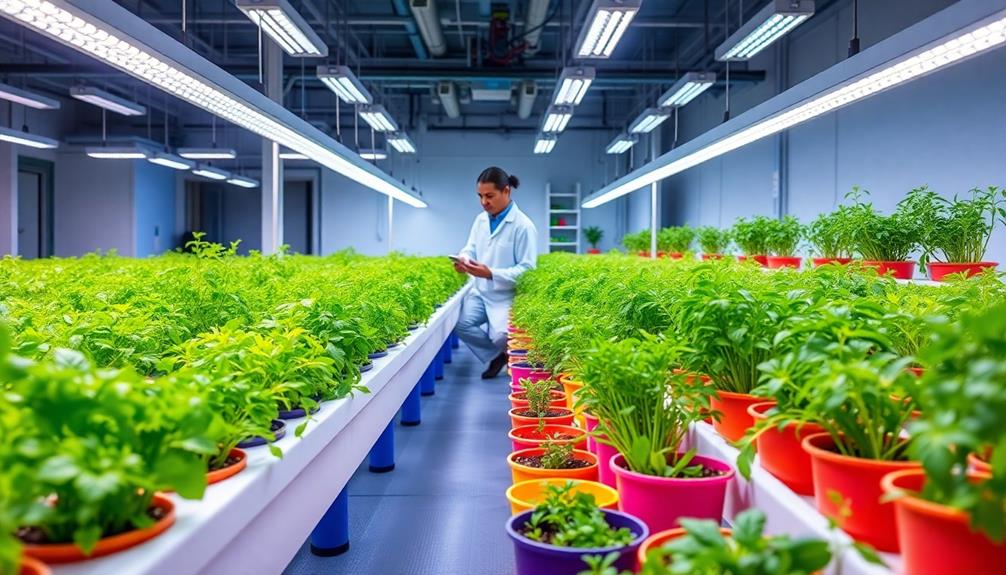
Innovatively, future trends in hydroponic flavor development are set to revolutionize how chefs and consumers experience herbs. By leveraging advanced nutrient management systems, you can expect precise adjustments in nutrient solutions that enhance flavor profiles, potentially boosting essential oil content by up to 20%.
The integration of LED lighting technology with adjustable light spectrums will further optimize aromatic compound production, leading to more intense and consistent flavors throughout the growing cycle.
Additionally, research shows that mild stress techniques, such as controlled water deprivation, can greatly enhance the flavor profiles of herbs like basil and mint, creating a more robust taste.
Artificial intelligence and machine learning will play a vital role, allowing for real-time monitoring and dynamic adjustments of growth conditions, including temperature and humidity, to optimize flavor.
Moreover, an increasing focus on sustainability practices, such as using organic nutrient sources, aligns with consumer preferences for healthier, pesticide-free options.
This combination of technology and sustainability not only promises to elevate the taste of hydroponically grown herbs but also guarantees that these practices meet the demands of the modern culinary landscape.
The future of flavor in hydroponics is indeed bright and flavorful.
Frequently Asked Questions
Do Hydroponic Herbs Taste Different?
Yes, hydroponic herbs often taste different. You'll notice they can be more vibrant and intense due to controlled nutrient delivery and ideal growing conditions, which enhance their flavor compounds compared to traditional soil-grown herbs.
Does Hydroponics Affect Taste?
Did you know that hydroponic herbs can have up to 30% more flavor compounds than soil-grown ones? Yes, hydroponics affects taste by allowing precise nutrient control and optimizing growth conditions, enhancing the overall flavor intensity.
Do Hydroponic Vegetables Have Less Flavor?
Hydroponic vegetables don't necessarily have less flavor. In fact, they often showcase enhanced taste due to precise nutrient delivery and controlled environments, allowing for consistent, robust flavors that many consumers actually prefer over traditional options.
Is Hydroponics Good for Herbs?
You might think hydroponics can't match soil-grown herbs, but that's not true. Hydroponics offers precise nutrient control, leading to vibrant flavors. Plus, you can customize conditions for your favorite herbs, enhancing their taste even more.
Conclusion
In the world of hydroponic farming, herbs flourish like vibrant brushstrokes on a culinary canvas, offering unique flavor profiles that captivate the senses. By controlling nutrients and environmental factors, you can access the true potential of these plants, often surpassing their soil-grown counterparts. As consumer preferences shift towards sustainability, the future of hydroponic herbs looks bright, promising an exciting evolution in taste that will transform your cooking experiences. Immerse yourself in this flavorful journey and savor the difference!
Lifestyle
Why Some Cultures Prioritize Medicinal Herbs in Their Cuisine
Curious about the culinary secrets of cultures that elevate medicinal herbs to essential ingredients? Discover the profound connection between food, health, and tradition.

Some cultures prioritize medicinal herbs in their cuisine because these herbs boost flavor and provide health benefits. In many societies, food isn't just about sustenance—it's integral to health and wellness. For instance, Traditional Chinese Medicine emphasizes the relationship between food and medicine, promoting longevity and illness prevention. Herbs like ginger and garlic offer proven health advantages, which make them valued staples. Cultural traditions often pass these practices down through generations, reflecting a holistic approach to cooking. If you're curious about how different cultures incorporate these herbs, you'll find even more fascinating insights.
Key Takeaways
- Many cultures view food as integral to health, blending culinary traditions with medicinal practices for holistic wellness.
- Traditional systems, like TCM, emphasize the preventative benefits of herbs, promoting longevity through diet.
- Herbal knowledge is often passed through generations, reinforcing cultural significance and practices in cuisine.
- The health benefits of herbs, such as anti-inflammatory and detoxifying properties, encourage their inclusion in daily meals.
- Increasing consumer interest in natural remedies reflects a shift towards prioritizing medicinal herbs in modern diets.
Historical Significance of Medicinal Herbs

Medicinal herbs have been woven into the fabric of human history, shaping culinary practices across cultures. You'll find that traditional Chinese medicine emphasizes the integration of food and medicine, highlighting a holistic approach to health and wellness.
This connection between culinary use of herbs and their medicinal properties has persisted for thousands of years, with ancient texts documenting their benefits. In Ethiopian cuisine, for example, ingredients like Yeselata (Ethiopian Salad) showcase the use of fresh vegetables, which not only provide flavor but also contribute to health through their nutritional value.
The spice trade played an essential role in this historical significance, as routes facilitated the exchange of valuable herbs like pepper, cinnamon, and cloves. These weren't just commodities; they became integral to cultural identity, influencing regional cuisines and their unique flavor profiles.
The introduction of new medicinal plants, such as vanilla and cocoa from the Americas, further expanded the repertoire of herbs, enriching both culinary traditions and natural remedies.
As you explore the historical significance of medicinal herbs, consider how their healing properties continue to impact modern cooking. The fusion of flavor and health in your meals not only honors past practices but also contributes to your well-being, reflecting the enduring legacy of these remarkable plants in our kitchens and lives.
Cultural Beliefs and Practices

Culinary traditions often reflect deep-rooted cultural beliefs and practices surrounding health and wellness. In many cultures, food isn't just about sustenance; it's an essential aspect of medicinal and holistic health.
For example, Traditional Chinese Medicine (TCM) emphasizes the medicinal properties of culinary ingredients, viewing food as crucial in preventing illness and promoting longevity. You might find that the Amazigh people incorporate medicinal herbs into their cuisine, blending nutritional and therapeutic benefits seamlessly.
Similarly, Japanese cuisine showcases this connection through ingredients like umeboshi (pickled plum), which is believed to aid digestion and enhance overall health.
Historical texts illustrate how various cultures have long integrated food and medicine, showcasing the belief in the health benefits of herbs and spices. This connection is evident in holistic health approaches, where dietary choices align with the energetic properties of food, such as the yin and yang concept in TCM.
Moreover, cultural practices surrounding the consumption of herbal medicine are often passed down through generations. This transmission of knowledge highlights the importance of traditional practices and their impact on community health.
Health Benefits and Nutritional Value

Herbs play a significant role in enhancing both the flavor and nutritional value of meals. These medicinal plants, rich in phytochemicals, offer a range of health benefits, including anti-inflammatory and antioxidant properties that contribute to your overall wellness and disease prevention.
In both East and West, culinary practices frequently incorporate herbs like ginger and turmeric. Modern research backs their traditional medicine uses, showing they aid digestion and reduce inflammation. For instance, the use of spices in dishes like Kawarma (Preserved Meat) not only elevates the taste but also brings various health benefits associated with the spices used.
When you add garlic and cilantro to your dishes, you're not just boosting flavor; you're also tapping into potential cardiovascular benefits and detoxifying properties. Regularly consuming herbs like basil and parsley can improve nutrient absorption and provide essential vitamins and minerals, making your diet more balanced.
Cultures worldwide recognize the role of these herbal medicines, emphasizing their importance in promoting health and preventing illness. By integrating these herbs into your meals, you're not just enjoying delicious food; you're also supplementing your nutritional intake with naturally sourced ingredients.
Integration in Culinary Traditions
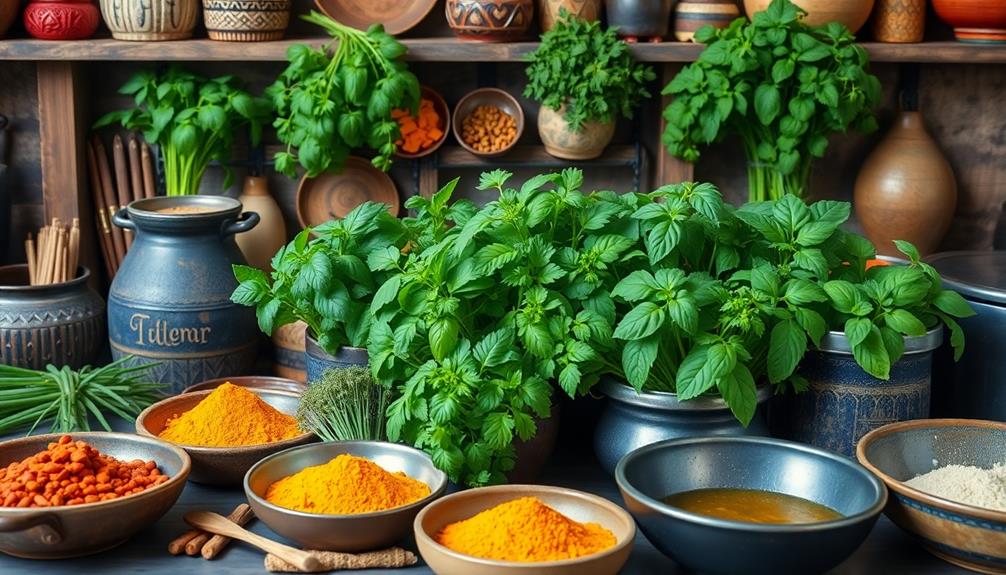
Harmony in cooking often stems from the seamless integration of flavor and health, a principle embraced by various cultures around the world. Many culinary traditions recognize that food isn't just for sustenance; it's essential for wellness.
For instance, Traditional Chinese Medicine (TCM) emphasizes the use of medicinal herbs to enhance health and prevent illness, weaving these elements into daily meals.
In Mediterranean diets, you'll find fresh herbs like parsley and basil used not only for their delightful flavors but also for their numerous health benefits.
Similarly, in Indian cuisine, Ayurvedic principles celebrate spices such as turmeric and ginger for their anti-inflammatory properties, showcasing the deep ties between food and well-being.
Cultural differences further enrich this integration, as Mexican cuisine also incorporates herbs like cilantro and epazote, valued for their medicinal effects.
These practices often get passed down through generations, with specific recipes designed to maximize both culinary and therapeutic benefits.
Modern Trends and Consumer Behavior
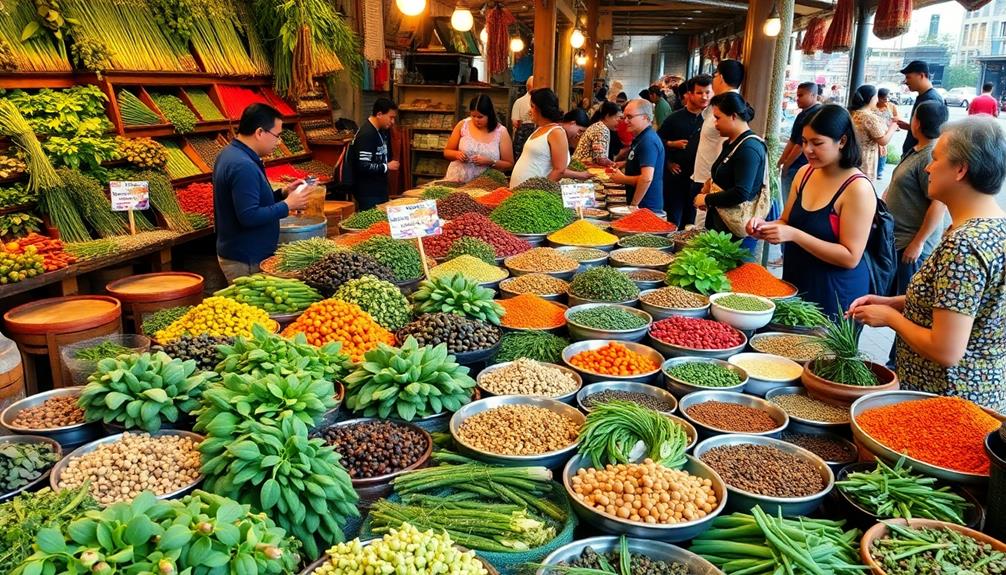
Embracing the resurgence of interest in herbal remedies, many consumers are shifting away from synthetic products in favor of natural options. This trend, especially pronounced after the COVID-19 pandemic, highlights a growing demand for immunity-boosting remedies.
You might notice that about 86% of Slovenians use medicinal herbs at least occasionally, despite nearly half being unfamiliar with them. This gap indicates that familiarity with these herbs greatly influences consumer behavior, affecting perceptions of their usefulness.
The principles of food and medicine homology, often seen in Chinese medicine, are gaining traction as people seek to integrate cultural traditions into their daily lives. Scientific research further supports the benefits of medicinal herbs for maintaining health, driving interest among various demographics.
Curiously, women and individuals over 55 tend to consume these herbs more frequently, often seeking relief for chronic conditions.
Additionally, over 60% of Slovenians believe that medicinal herbs should be covered by health insurance, emphasizing a desire for better integration of herbal remedies within healthcare policies.
As modern trends evolve, you'll find that the appreciation for medicinal herbs continues to grow, reshaping the culinary landscape.
Frequently Asked Questions
Why Are Medicinal Herbs Important?
Medicinal herbs are important because they offer numerous health benefits, enhancing your well-being. Their anti-inflammatory, antibacterial, and antioxidant properties can support your body's functions, making them valuable additions to your diet and health practices.
What Cultures Believe in Herbal Medicine?
You'll find that cultures like Traditional Chinese Medicine, Ayurveda, and Indigenous practices believe in herbal medicine. These traditions emphasize using plants for healing, showcasing a deep-rooted connection between health, food, and cultural identity.
Why Are Herbs Important in Chinese Medicine?
Herbs are essential in Chinese medicine because they enhance your health through a holistic approach. They balance yin and yang, support important functions, and provide natural remedies for everyday wellness, ultimately promoting longevity and vitality.
Which Country Has Most Medicinal Herbs?
Did you know China boasts over 11,000 species of medicinal herbs? When you explore Traditional Chinese Medicine, you'll discover the depth of knowledge and practices surrounding these herbs, making China the leader in medicinal herb diversity.
Conclusion
Incorporating medicinal herbs into cuisine isn't just about flavor; it's about embracing a rich heritage and nurturing health. As you explore different cultures, you'll discover that these herbs serve a purpose beyond the plate. By choosing to include them in your meals, you're not just spicing things up—you're honoring age-old traditions that have stood the test of time. So, why not take a leaf out of their book and enrich your culinary experiences with these vibrant, healing ingredients?
Lifestyle
The Science Behind Food-Induced Sense of Wellbeing in Different Climates
With climate influencing our food choices, discover how these dynamics can elevate your mood and overall wellbeing in surprising ways.

Food plays a vital role in your wellbeing, but its effects vary with climate. In warmer regions, fresh fruits and vegetables boost mood and provide essential nutrients, while colder climates often favor heartier, calorie-dense foods for energy. Your nutritional needs also shift; diets rich in omega-3s can combat depression, while local and seasonal ingredients increase food security and emotional health. Cultural practices shape your food choices, reinforcing community bonds. Understanding these dynamics can enhance your overall sense of wellbeing, especially when you consider how different climates impact your food and mood.
Key Takeaways
- Food security enhances emotional stability and cognitive function by reducing stress and anxiety levels across different climates.
- Nutritional needs vary by climate; balanced diets rich in omega-3s and micronutrients support mental health and overall wellbeing.
- Climate change affects food availability, increasing food deserts and impacting nutritional quality, which can lead to malnutrition and mental health issues.
- Seasonal eating practices, like those in the Mediterranean diet, promote nutrient density and emotional health while addressing seasonal deficiencies.
- Cultural practices and local ingredients strengthen community bonds and support mental health, reflecting the significance of food in various climates.
Understanding Food-Induced Wellbeing
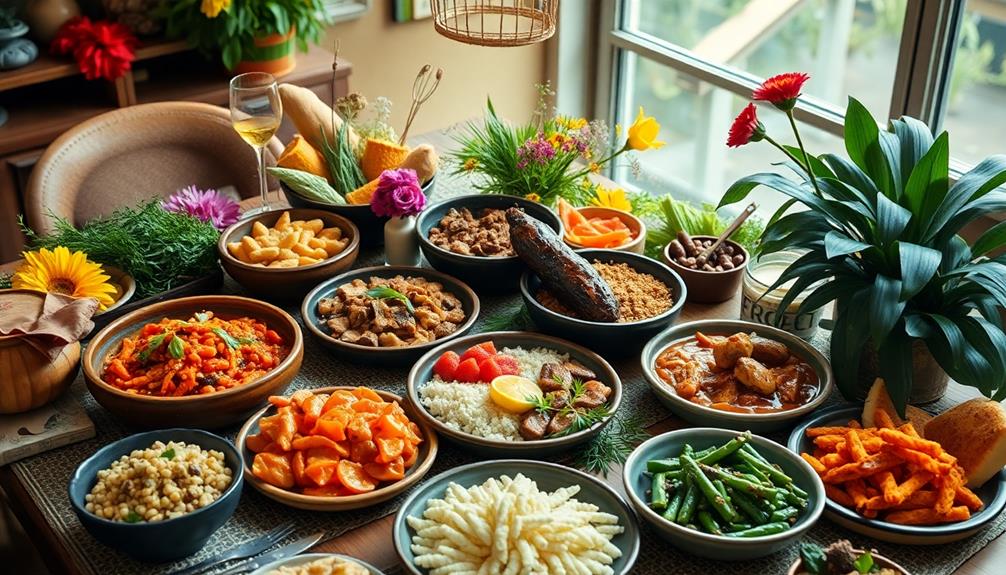
Food-induced wellbeing is an important aspect of overall mental health that you mightn't fully appreciate. When you have food security, the stress of not knowing where your next meal will come from diminishes, leading to improved emotional stability and cognitive function.
A balanced diet is essential, as nutritional deficiencies can negatively impact your mood, contributing to higher rates of anxiety and depression. Traditional foods, such as Red-Braised Pork Belly, can provide comfort and a sense of connection to culture, enhancing feelings of wellbeing.
Consider adopting the Mediterranean diet, which includes plenty of fruits, vegetables, whole grains, and healthy fats. This diet has been linked to reduced depression risk and enhanced mental health outcomes. Omega-3 fatty acids, found in oily fish, play a significant role in this process, offering anti-inflammatory properties that may alleviate symptoms of anxiety and depression.
Moreover, hydration is often overlooked but is critical for mental health. Even mild dehydration can affect your mood and cognitive performance, so make sure you're drinking enough fluids throughout the day.
Climate's Influence on Nutrition

Recognizing the impact of climate on nutrition is essential for understanding food security and health outcomes. Climate change considerably alters the availability and diversity of nutritious food, which can be seen in regions where traditional dishes like Cuscuz Paulista reflect local agricultural practices.
Warmer temperatures and unpredictable precipitation patterns can reduce crop yields, leading to food insecurity in many regions. In areas experiencing extreme weather events, such as droughts or floods, the nutritional quality of food often declines, which can contribute to malnutrition and related mental health issues.
You might find that regions affected by food deserts, a situation worsened by climate change, struggle to access fresh and healthy foods. This lack of access fosters poor dietary patterns and negative health outcomes.
Additionally, your nutritional needs can vary based on climate. For instance, individuals in hotter climates may require unique hydration and dietary strategies to stay healthy.
As climate-related challenges to food production increase, many people turn to processed and less nutritious foods. This reliance can have detrimental effects on overall health, making it harder for you to achieve ideal mental and emotional well-being.
Adapting to these changes is crucial for maintaining a balanced diet that supports your health in varying climates.
Nutritional Components and Mood

Your mood can shift dramatically based on the nutrients you consume. For instance, omega-3 fatty acids found in oily fish have been linked to improved mental health, while deficiencies in key vitamins and minerals may lead to anxiety and mood swings.
Additionally, incorporating a variety of nutrient-rich foods, such as those found in Indian cuisine like Mushroom Masala, can further enhance your emotional state. By focusing on a balanced diet rich in these essential components, you can support your emotional well-being.
Nutrient Impact on Mood
Nutritional components play a significant role in shaping your mood and overall mental wellbeing. The nutrient impact on mental health is profound; deficiencies in micronutrients like folate, zinc, magnesium, and vitamin D can lead to increased anxiety and mood swings. A balanced diet rich in fruits, vegetables, whole grains, and healthy fats promotes emotional wellbeing and protects against mood disorders.
| Nutrient | Impact on Mood |
|---|---|
| Omega-3 Fatty Acids | Lower depression rates |
| Fruits | Support gut-brain connection |
| Vegetables | Rich in micronutrients |
| Whole Grains | Stabilize blood sugar, improve energy |
| Hydration | Essential for cognitive performance |
Even mild dehydration can negatively affect your mood, making hydration vital. The gut-brain connection shows that a diverse, plant-rich diet supports gut microbiome health, which is integral for mood regulation and neurotransmitter production. By focusing on these nutritional components, you can enhance your mental health and experience improved emotional wellbeing day by day.
Omega-3 and Mental Health
Omega-3 fatty acids are essential players in promoting mental health, with studies showing that individuals consuming high amounts of these nutrients, particularly from oily fish, experience markedly lower rates of depression.
Research indicates that incorporating omega-3-rich foods into your diet, like salmon, flaxseeds, and walnuts, can boost your mood and overall wellbeing.
Clinical trials suggest that omega-3 supplementation at around 1 gram per day can elevate your mood, which is roughly equivalent to eating three salmon fillets each week.
If you're facing increased anxiety or mood disorders, it's important to take into account potential deficiencies in omega-3s, as these are linked to heightened mental health challenges.
The anti-inflammatory properties of omega-3 fatty acids may also help alleviate neurological symptoms, providing additional support for your mental health.
By prioritizing food consumption that includes these essential nutrients, you can actively work towards better emotional stability.
Cultural Practices and Food Choices

When you think about your food choices, consider how traditional food rituals shape your diet and connect you to your culture.
Using local ingredients not only enhances flavor but also supports your community and reflects the environment you live in.
Traditional Food Rituals
Traditional food rituals play an essential role in shaping cultural identity and fostering community bonds. They create shared experiences that enhance emotional wellbeing and strengthen social ties. When you engage in these rituals, you're not just enjoying a meal; you're participating in a tradition that connects you to your heritage and community.
- Emphasizing the use of omega-3-rich fish in Scandinavian diets
- Celebrating communal dining with plant-based foods in Mediterranean cultures
- Incorporating seasonal ingredients in indigenous food practices
- Practicing mindful eating through rituals like Japan's "Ikigai"
- Building resilience and mental wellness through shared meals
Many cultures weave specific ingredients into their rituals, promoting health and happiness. For instance, Mediterranean diets focus on plant-based foods known for their mental health benefits.
Likewise, Scandinavian traditions highlight omega-3-rich fish, linked to lower depression rates. Seasonal ingredients not only boost physical health but also foster a connection to the land.
Local Ingredients Significance
Eating locally sourced ingredients can greatly enhance your connection to cultural practices and food choices. When you embrace local ingredients, you're not just supporting traditional diets; you're also nurturing your body and mind.
Studies show that communities using indigenous foods often enjoy better nutritional outcomes and mental health. By choosing seasonal ingredients, you contribute to food security, fostering a sense of belonging and well-being within your community.
Opting for traditional diets, such as the Mediterranean diet rich in fruits, vegetables, and whole grains, is linked to lower depression rates, promoting mental health. Additionally, local food choices typically have a reduced carbon footprint, benefiting both environmental wellbeing and your individual health.
Engaging with local food systems strengthens social ties and community resilience, which are essential for psychological well-being, especially in the face of climate-related stressors.
Climate-Responsive Dietary Habits
Climate-responsive dietary habits reflect how communities adapt their food choices to local environmental conditions.
You'll notice that these habits often arise from cultural practices that guarantee the sustainability of nutritional intake while enhancing psychological wellbeing.
Consider these points:
- Drought-resistant crops are favored in arid regions.
- Seafood is prioritized in coastal areas.
- High-calorie foods are common in harsh winters.
- Fresh fruits and vegetables dominate in tropical climates.
- Indigenous diets utilize local flora and fauna.
Seasonal Variations in Diet

Seasonal variations in diet play an essential role in your overall wellbeing, particularly as they influence nutrient availability throughout the year. In winter, for instance, you might find yourself relying more on comfort foods, which can temporarily boost your mood but often lead to poor dietary quality and potential vitamin deficiencies, especially in vitamins C and D.
These deficiencies can negatively impact your mental health, particularly if you experience seasonal affective disorder (SAD), where reduced sunlight exposure lowers serotonin levels.
Conversely, embracing a Mediterranean diet rich in seasonal fruits, vegetables, and healthy fats can enhance your mood and overall wellbeing. This diet not only supports mental health but also emphasizes the importance of locally-sourced foods, promoting food security in your community.
By choosing foods that are in season, you maximize nutrient availability and can help combat the emotional downturns often associated with colder months.
Ultimately, adjusting your diet according to seasonal variations allows you to maintain a balanced intake of nutrients, supporting your mental health and helping you feel more connected to the environment around you.
Community Connections and Wellbeing

Community connections are crucial for enhancing your overall wellbeing, especially when it comes to food access. When you engage with your community, you not only improve food security but also foster relationships that can uplift your mental health.
- Access to nutritious food can reduce stress and anxiety.
- Social support networks are essential for addressing food-related challenges.
- Community initiatives can combat the effects of food deserts.
- Increased food availability can boost emotional wellbeing.
- Collaborative programs can integrate food security with mental health support.
In areas known as food deserts, limited access to affordable, nutritious food can lead to unhealthy eating habits and increased obesity risks. By participating in community initiatives, you can help improve food availability and foster local networks that enhance social support.
Research shows that emotional wellbeing improves when you have access to shared resources, highlighting the significance of community connections.
When communities come together to support each other, they tackle food insecurity more effectively, which in turn strengthens mental health outcomes.
Frequently Asked Questions
How Does Food Affect Your Wellbeing?
Food directly impacts your wellbeing by providing essential nutrients that boost mood and cognitive function. A balanced diet, rich in fruits, vegetables, and healthy fats, can enhance your mental health and overall sense of happiness.
How Does Climate Change Affect the Food System?
Climate change disrupts the food system by altering crop yields and availability. You'll notice increasing food insecurity and changing dietary patterns, impacting your nutrition and overall wellbeing as extreme weather events become more common.
How Does Climate Change Affect Nutritional Quality of Food?
Did you know that rising CO2 levels can cut protein content in crops by up to 30%? Climate change affects nutritional quality, leaving you and others vulnerable to deficiencies in essential nutrients crucial for health.
How Does Food Affect Your Health and Wellbeing?
Food directly impacts your health and wellbeing. A balanced diet boosts your mood, enhances cognitive functions, and reduces anxiety. Eating nutrient-rich foods helps regulate emotions, while hydration guarantees your mind stays sharp and stable.
Conclusion
As you savor a warm bowl of soup on a chilly day, you can feel the comforting embrace of nourishment wrapping around you. In every bite, the flavors dance, lifting your spirits and connecting you to the vibrant tapestry of your culture. Whether it's fresh summer fruits or hearty winter stews, the climate shapes not just what you eat, but how you feel. Embrace this harmony, and let your meals be a celebration of both nature and wellbeing.
-

 Vetted8 months ago
Vetted8 months ago15 Best EMS Foot Massagers for Neuropathy to Soothe Your Feet
-

 Vetted7 months ago
Vetted7 months ago14 Best Personalized Father's Day Gifts for Your Husband – Show Him You Care
-

 Alfresco6 months ago
Alfresco6 months agoAlfresco Stacker Doors: Seamless Indoor-Outdoor Living!
-

 Tableware and Dining Accessories1 week ago
Tableware and Dining Accessories1 week agoWhat Is the Meaning of the Word Tableware
-

 Tableware and Dining Accessories1 week ago
Tableware and Dining Accessories1 week agoWhen Is Tableware on Sale at Hobby Lobby
-

 Tableware and Dining Accessories1 week ago
Tableware and Dining Accessories1 week agoWhich of the Following Is Not Classified as Tableware
-

 Craft and Textiles8 months ago
Craft and Textiles8 months ago15 Best Places to Buy Appliances for Your Home – Top Retailers Reviewed
-

 Tableware and Dining Accessories1 week ago
Tableware and Dining Accessories1 week agoWhat Is the Hindi Meaning of Tableware





























